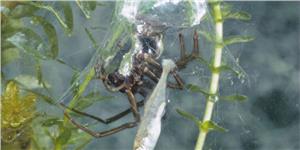Why You Keep Hearing About Huge Broods of Cicadas
The cicadas are back, baby! This spring, billions of cicadas across the eastern half of the U.S. will emerge from their multiyear slumber to festoon the trees and sing their loud songs. Brood XIX will emerge for the first time since 2011, Brood XIII for the first time since 2007, and it's all especially exciting because these two broods haven't emerged simultaneously since 1803. But wait. Weren't we just hearing about a cicada-geddon a few years ago, when Brood X flooded headlines in 2021? And before that, Brood IX in 2020? Brood VIII the year before that? Is anyone else getting some cicada déjà vu? There are many different broods of periodical cicadas, each one a big batch of bugs born in the same year and in the same geographical area. Periodical cicadas burrow into the ground shortly after hatching and spend either 13 or 17 years nestled in a little mud cell, until finally they emerge for mating fiesta. This lasts about a month. The females lay their eggs in the trees. Then the adults all die. ![]() 1/1 Skip Ad Continue watchingafter the adVisit Advertiser websiteGO TO PAGE Across America, there are three 13-year broods and 12 17-year broods, each on their own schedule. That makes for a big number of broods that will, at some point, emerge in tandem. That's why you can find periodical cicadas, which are black with red eyes, almost any year if you travel to the right place. In fact, because there are so many broods, it's weirder to have a year without an emergence than to have a year with one. (Note that the periodicals are not to be confused with the annual cicadas, which emerge every year—those guys have greenish-brown bodies and come out in late summer, earning them the nickname "dog-day cicadas.") Advertisement Which broods the national media go wild over often has to do with their location, says cicada expert Chris Simon of the University of Connecticut. The more-talked-about broods are the ones near cities: Brood X gets a ton of coverage because it's near D.C. and Baltimore, and Brood II does because it's in the New Jersey–New York metro area. Advertisement Advertisement Advertisement Yet, the 2024 emergences are not being overhyped, say scientists. "This year is definitely a bigger thing than it has been in the past," says Catherine Dana, an entomologist at the Illinois Natural History Survey. It marks the first time since 1998 that geographically adjacent 13- and 17-year broods have coemerged. Because of the two broods' locations, almost all of Illinois will be covered in cicadas. (A common misunderstanding is that there will be double the density of cicadas, but the two broods actually abut each other and don't overlap. The range of cicadas will just be very large.) Advertisement Also notable is that all seven periodical cicada species—broods contain multiple species—will be out in the same year. That won't happen again until 2037. This year is an exciting one too because we've been in a real cicada lull lately—no broods have emerged at all since 2021. "I know it's like 'OK, we did this three years ago for Brood X,' " Dana says. But to a cicada researcher, every brood emergence is a big deal. The rest of the year is spent gathering baseline data at the sites; analyzing the hundreds of cicada samples collected during emergence years and stored in freezers ("It's a lot of freezers. … My home freezer is packed too," says Dana); and preparing for all the work that has to happen in the short window when the bugs are up top. Advertisement Advertisement "I get a pang of anxiety when the flowers start to come up," says Dana. "I'm like, Oh my gosh, do I have permits in place? Do I have a research plan? Do I have the supplies that I'm gonna need?" By that time, the cicadas have already started prepping for their big moment. The winter before emergence, their eyes turn from white to bright red. Then, a couple of months before spring, each cicada digs a footlong tunnel to the surface and starts to practice its escape—sometimes you can catch them poking their heads out from the ground, peering around at their new world. But they won't leave their hole until the soil temperature reaches 64 degrees. Advertisement Advertisement This year, that means we'll likely start seeing the critters in May through early June. Then, for scientists, it'll be a frenzy of collection and measuring, says John Lill, an ecologist at the George Washington University. Lill's interest is less in the cicadas themselves, and more in the ways the brief cicada explosions affect other creatures in the aboveground world. A pulse of bugs provides a feast for predators like birds, squirrels, raccoons, and ants—who would all be new to seeing periodical cicadas. "They're all naïve to the fact that [the cicadas are] coming out, because most organisms don't live 13 or 17 years," says Lill. Besides people, "nothing else really knows that they're coming." Advertisement Advertisement Advertisement Less naïve, however, is the journalist, who emerges along with the broods. "During Brood X, I talked to more than 75 different journalists," recalls Simon. Her collaborator spoke to another 75 journalists on top of that. "And now it's getting more and more. More and more people want to write about them." Clearly, cicadas have really great PR. But, as comes with fame, it's not all good press. Sometimes it's simply misconceptions; Simon has a list of terms that she considers "media faux pas" for journalists covering cicadas, which include sleeping underground (the insects aren't sleeping; they're growing, eating, and shedding their skin), swarm (although they do gather in large numbers, they don't fly together as a coordinated entity, per the technical definition of swarming), and alarming ("Rather than thinking of them as alarming, think of having a 'David Attenborough special' in your own backyard as my colleague Gene Kritsky likes to say," the list advises). Advertisement Other times, the events are framed as "attack of the cicadas, painting them as scary, dangerous, other," says Martha Weiss, an ecologist at Georgetown University. "I think that many cicada researchers take a little bit of umbrage at [that]." Advertisement Advertisement Of course—and maybe I am just being a journalist about this—a burst of cicadas can be a nuisance. In dense areas, you can have cicadas flying—even if not in a coordinated group—around you, landing on you, getting stuck in your hair. When the bugs die, their carcasses rot and smell. And their singing can get incredibly loud, so much so that some of Dana's technicians wear earplugs in the field, and spring weddings have been crashed. Advertisement But cicadas are harmless to people—they can't sting or bite—and mostly harmless to plants, other than very young trees, which can be protected with netting during the week when females lay eggs in tree branches. Scientists look at it like this: "It's not really fair for us to think of them as alien invaders descending on us and wreaking havoc," says Weiss. "We're privileged to live in the places that they call home and come up to say hello every once in a while." Besides, they are usually very quiet neighbors, living peacefully beneath our feet. Well, they are also something else. This June, for the 2024 coemergence, Weiss is hosting a "cicada party" with a variety of themed foods, including chocolate-covered cicadas and teriyaki-marinated cicada skewers. "I call them 'tree shrimp,' " she says, regarding eating them. Advertisement Advertisement Advertisement
1/1 Skip Ad Continue watchingafter the adVisit Advertiser websiteGO TO PAGE Across America, there are three 13-year broods and 12 17-year broods, each on their own schedule. That makes for a big number of broods that will, at some point, emerge in tandem. That's why you can find periodical cicadas, which are black with red eyes, almost any year if you travel to the right place. In fact, because there are so many broods, it's weirder to have a year without an emergence than to have a year with one. (Note that the periodicals are not to be confused with the annual cicadas, which emerge every year—those guys have greenish-brown bodies and come out in late summer, earning them the nickname "dog-day cicadas.") Advertisement Which broods the national media go wild over often has to do with their location, says cicada expert Chris Simon of the University of Connecticut. The more-talked-about broods are the ones near cities: Brood X gets a ton of coverage because it's near D.C. and Baltimore, and Brood II does because it's in the New Jersey–New York metro area. Advertisement Advertisement Advertisement Yet, the 2024 emergences are not being overhyped, say scientists. "This year is definitely a bigger thing than it has been in the past," says Catherine Dana, an entomologist at the Illinois Natural History Survey. It marks the first time since 1998 that geographically adjacent 13- and 17-year broods have coemerged. Because of the two broods' locations, almost all of Illinois will be covered in cicadas. (A common misunderstanding is that there will be double the density of cicadas, but the two broods actually abut each other and don't overlap. The range of cicadas will just be very large.) Advertisement Also notable is that all seven periodical cicada species—broods contain multiple species—will be out in the same year. That won't happen again until 2037. This year is an exciting one too because we've been in a real cicada lull lately—no broods have emerged at all since 2021. "I know it's like 'OK, we did this three years ago for Brood X,' " Dana says. But to a cicada researcher, every brood emergence is a big deal. The rest of the year is spent gathering baseline data at the sites; analyzing the hundreds of cicada samples collected during emergence years and stored in freezers ("It's a lot of freezers. … My home freezer is packed too," says Dana); and preparing for all the work that has to happen in the short window when the bugs are up top. Advertisement Advertisement "I get a pang of anxiety when the flowers start to come up," says Dana. "I'm like, Oh my gosh, do I have permits in place? Do I have a research plan? Do I have the supplies that I'm gonna need?" By that time, the cicadas have already started prepping for their big moment. The winter before emergence, their eyes turn from white to bright red. Then, a couple of months before spring, each cicada digs a footlong tunnel to the surface and starts to practice its escape—sometimes you can catch them poking their heads out from the ground, peering around at their new world. But they won't leave their hole until the soil temperature reaches 64 degrees. Advertisement Advertisement This year, that means we'll likely start seeing the critters in May through early June. Then, for scientists, it'll be a frenzy of collection and measuring, says John Lill, an ecologist at the George Washington University. Lill's interest is less in the cicadas themselves, and more in the ways the brief cicada explosions affect other creatures in the aboveground world. A pulse of bugs provides a feast for predators like birds, squirrels, raccoons, and ants—who would all be new to seeing periodical cicadas. "They're all naïve to the fact that [the cicadas are] coming out, because most organisms don't live 13 or 17 years," says Lill. Besides people, "nothing else really knows that they're coming." Advertisement Advertisement Advertisement Less naïve, however, is the journalist, who emerges along with the broods. "During Brood X, I talked to more than 75 different journalists," recalls Simon. Her collaborator spoke to another 75 journalists on top of that. "And now it's getting more and more. More and more people want to write about them." Clearly, cicadas have really great PR. But, as comes with fame, it's not all good press. Sometimes it's simply misconceptions; Simon has a list of terms that she considers "media faux pas" for journalists covering cicadas, which include sleeping underground (the insects aren't sleeping; they're growing, eating, and shedding their skin), swarm (although they do gather in large numbers, they don't fly together as a coordinated entity, per the technical definition of swarming), and alarming ("Rather than thinking of them as alarming, think of having a 'David Attenborough special' in your own backyard as my colleague Gene Kritsky likes to say," the list advises). Advertisement Other times, the events are framed as "attack of the cicadas, painting them as scary, dangerous, other," says Martha Weiss, an ecologist at Georgetown University. "I think that many cicada researchers take a little bit of umbrage at [that]." Advertisement Advertisement Of course—and maybe I am just being a journalist about this—a burst of cicadas can be a nuisance. In dense areas, you can have cicadas flying—even if not in a coordinated group—around you, landing on you, getting stuck in your hair. When the bugs die, their carcasses rot and smell. And their singing can get incredibly loud, so much so that some of Dana's technicians wear earplugs in the field, and spring weddings have been crashed. Advertisement But cicadas are harmless to people—they can't sting or bite—and mostly harmless to plants, other than very young trees, which can be protected with netting during the week when females lay eggs in tree branches. Scientists look at it like this: "It's not really fair for us to think of them as alien invaders descending on us and wreaking havoc," says Weiss. "We're privileged to live in the places that they call home and come up to say hello every once in a while." Besides, they are usually very quiet neighbors, living peacefully beneath our feet. Well, they are also something else. This June, for the 2024 coemergence, Weiss is hosting a "cicada party" with a variety of themed foods, including chocolate-covered cicadas and teriyaki-marinated cicada skewers. "I call them 'tree shrimp,' " she says, regarding eating them. Advertisement Advertisement Advertisement Related From Slate
![]()
Dan Kois
My Cicada Wedding: An Interview With a Bride Who Just Realized Her Ceremony Will Likely Be Overrun by Horny Insects
Read More Recommended for You
![]()
Another Person Was Infected With Bird Flu. What's Going On?
![]()
What Was the Real First Name of Lady Bird Johnson?
![]()
One Day 10 Years Ago, I Stopped Paying My Taxes. I Don't Regret a Thing.
The emergence really is going to be a whole event. Dana has gotten several emails from people about traveling to Illinois during Memorial Day weekend to see the emergence. She recommends that people go to city parks and look for trees, as cicadas prefer vertical surfaces. "It's one of those core memories, especially for kids," says Dana. We travel great distances to see natural wonders like the northern lights, monarch butterflies, sandhill cranes, solar eclipses. Why wouldn't we add cicada emergences to the bucket list? Advertisement I know I've added it to mine, partly because of how the researchers I spoke with waxed poetic when they talked about their bugs. The periodical cicadas unfurl from their skin "like flowers," and their nymphs float from the trees "like snowflakes"; the sun glints through their gossamer wings as they fly overhead; the forest comes alive with crackling leaves when they crawl out of their holes in the dark. "They're just amazing," says Simon. Go and listen to the cicadas coming out at night, she says. And the next morning, "it's like Christmas. It's like getting trillions of presents. Cicadas will just be everywhere."

 1/1 Skip Ad Continue watchingafter the adVisit Advertiser websiteGO TO PAGE Across America, there are three 13-year broods and 12 17-year broods, each on their own schedule. That makes for a big number of broods that will, at some point, emerge in tandem. That's why you can find periodical cicadas, which are black with red eyes, almost any year if you travel to the right place. In fact, because there are so many broods, it's weirder to have a year without an emergence than to have a year with one. (Note that the periodicals are not to be confused with the annual cicadas, which emerge every year—those guys have greenish-brown bodies and come out in late summer, earning them the nickname "dog-day cicadas.") Advertisement Which broods the national media go wild over often has to do with their location, says cicada expert Chris Simon of the University of Connecticut. The more-talked-about broods are the ones near cities: Brood X gets a ton of coverage because it's near D.C. and Baltimore, and Brood II does because it's in the New Jersey–New York metro area. Advertisement Advertisement Advertisement Yet, the 2024 emergences are not being overhyped, say scientists. "This year is definitely a bigger thing than it has been in the past," says Catherine Dana, an entomologist at the Illinois Natural History Survey. It marks the first time since 1998 that geographically adjacent 13- and 17-year broods have coemerged. Because of the two broods' locations, almost all of Illinois will be covered in cicadas. (A common misunderstanding is that there will be double the density of cicadas, but the two broods actually abut each other and don't overlap. The range of cicadas will just be very large.) Advertisement Also notable is that all seven periodical cicada species—broods contain multiple species—will be out in the same year. That won't happen again until 2037. This year is an exciting one too because we've been in a real cicada lull lately—no broods have emerged at all since 2021. "I know it's like 'OK, we did this three years ago for Brood X,' " Dana says. But to a cicada researcher, every brood emergence is a big deal. The rest of the year is spent gathering baseline data at the sites; analyzing the hundreds of cicada samples collected during emergence years and stored in freezers ("It's a lot of freezers. … My home freezer is packed too," says Dana); and preparing for all the work that has to happen in the short window when the bugs are up top. Advertisement Advertisement "I get a pang of anxiety when the flowers start to come up," says Dana. "I'm like, Oh my gosh, do I have permits in place? Do I have a research plan? Do I have the supplies that I'm gonna need?" By that time, the cicadas have already started prepping for their big moment. The winter before emergence, their eyes turn from white to bright red. Then, a couple of months before spring, each cicada digs a footlong tunnel to the surface and starts to practice its escape—sometimes you can catch them poking their heads out from the ground, peering around at their new world. But they won't leave their hole until the soil temperature reaches 64 degrees. Advertisement Advertisement This year, that means we'll likely start seeing the critters in May through early June. Then, for scientists, it'll be a frenzy of collection and measuring, says John Lill, an ecologist at the George Washington University. Lill's interest is less in the cicadas themselves, and more in the ways the brief cicada explosions affect other creatures in the aboveground world. A pulse of bugs provides a feast for predators like birds, squirrels, raccoons, and ants—who would all be new to seeing periodical cicadas. "They're all naïve to the fact that [the cicadas are] coming out, because most organisms don't live 13 or 17 years," says Lill. Besides people, "nothing else really knows that they're coming." Advertisement Advertisement Advertisement Less naïve, however, is the journalist, who emerges along with the broods. "During Brood X, I talked to more than 75 different journalists," recalls Simon. Her collaborator spoke to another 75 journalists on top of that. "And now it's getting more and more. More and more people want to write about them." Clearly, cicadas have really great PR. But, as comes with fame, it's not all good press. Sometimes it's simply misconceptions; Simon has a list of terms that she considers "media faux pas" for journalists covering cicadas, which include sleeping underground (the insects aren't sleeping; they're growing, eating, and shedding their skin), swarm (although they do gather in large numbers, they don't fly together as a coordinated entity, per the technical definition of swarming), and alarming ("Rather than thinking of them as alarming, think of having a 'David Attenborough special' in your own backyard as my colleague Gene Kritsky likes to say," the list advises). Advertisement Other times, the events are framed as "attack of the cicadas, painting them as scary, dangerous, other," says Martha Weiss, an ecologist at Georgetown University. "I think that many cicada researchers take a little bit of umbrage at [that]." Advertisement Advertisement Of course—and maybe I am just being a journalist about this—a burst of cicadas can be a nuisance. In dense areas, you can have cicadas flying—even if not in a coordinated group—around you, landing on you, getting stuck in your hair. When the bugs die, their carcasses rot and smell. And their singing can get incredibly loud, so much so that some of Dana's technicians wear earplugs in the field, and spring weddings have been crashed. Advertisement But cicadas are harmless to people—they can't sting or bite—and mostly harmless to plants, other than very young trees, which can be protected with netting during the week when females lay eggs in tree branches. Scientists look at it like this: "It's not really fair for us to think of them as alien invaders descending on us and wreaking havoc," says Weiss. "We're privileged to live in the places that they call home and come up to say hello every once in a while." Besides, they are usually very quiet neighbors, living peacefully beneath our feet. Well, they are also something else. This June, for the 2024 coemergence, Weiss is hosting a "cicada party" with a variety of themed foods, including chocolate-covered cicadas and teriyaki-marinated cicada skewers. "I call them 'tree shrimp,' " she says, regarding eating them. Advertisement Advertisement Advertisement
1/1 Skip Ad Continue watchingafter the adVisit Advertiser websiteGO TO PAGE Across America, there are three 13-year broods and 12 17-year broods, each on their own schedule. That makes for a big number of broods that will, at some point, emerge in tandem. That's why you can find periodical cicadas, which are black with red eyes, almost any year if you travel to the right place. In fact, because there are so many broods, it's weirder to have a year without an emergence than to have a year with one. (Note that the periodicals are not to be confused with the annual cicadas, which emerge every year—those guys have greenish-brown bodies and come out in late summer, earning them the nickname "dog-day cicadas.") Advertisement Which broods the national media go wild over often has to do with their location, says cicada expert Chris Simon of the University of Connecticut. The more-talked-about broods are the ones near cities: Brood X gets a ton of coverage because it's near D.C. and Baltimore, and Brood II does because it's in the New Jersey–New York metro area. Advertisement Advertisement Advertisement Yet, the 2024 emergences are not being overhyped, say scientists. "This year is definitely a bigger thing than it has been in the past," says Catherine Dana, an entomologist at the Illinois Natural History Survey. It marks the first time since 1998 that geographically adjacent 13- and 17-year broods have coemerged. Because of the two broods' locations, almost all of Illinois will be covered in cicadas. (A common misunderstanding is that there will be double the density of cicadas, but the two broods actually abut each other and don't overlap. The range of cicadas will just be very large.) Advertisement Also notable is that all seven periodical cicada species—broods contain multiple species—will be out in the same year. That won't happen again until 2037. This year is an exciting one too because we've been in a real cicada lull lately—no broods have emerged at all since 2021. "I know it's like 'OK, we did this three years ago for Brood X,' " Dana says. But to a cicada researcher, every brood emergence is a big deal. The rest of the year is spent gathering baseline data at the sites; analyzing the hundreds of cicada samples collected during emergence years and stored in freezers ("It's a lot of freezers. … My home freezer is packed too," says Dana); and preparing for all the work that has to happen in the short window when the bugs are up top. Advertisement Advertisement "I get a pang of anxiety when the flowers start to come up," says Dana. "I'm like, Oh my gosh, do I have permits in place? Do I have a research plan? Do I have the supplies that I'm gonna need?" By that time, the cicadas have already started prepping for their big moment. The winter before emergence, their eyes turn from white to bright red. Then, a couple of months before spring, each cicada digs a footlong tunnel to the surface and starts to practice its escape—sometimes you can catch them poking their heads out from the ground, peering around at their new world. But they won't leave their hole until the soil temperature reaches 64 degrees. Advertisement Advertisement This year, that means we'll likely start seeing the critters in May through early June. Then, for scientists, it'll be a frenzy of collection and measuring, says John Lill, an ecologist at the George Washington University. Lill's interest is less in the cicadas themselves, and more in the ways the brief cicada explosions affect other creatures in the aboveground world. A pulse of bugs provides a feast for predators like birds, squirrels, raccoons, and ants—who would all be new to seeing periodical cicadas. "They're all naïve to the fact that [the cicadas are] coming out, because most organisms don't live 13 or 17 years," says Lill. Besides people, "nothing else really knows that they're coming." Advertisement Advertisement Advertisement Less naïve, however, is the journalist, who emerges along with the broods. "During Brood X, I talked to more than 75 different journalists," recalls Simon. Her collaborator spoke to another 75 journalists on top of that. "And now it's getting more and more. More and more people want to write about them." Clearly, cicadas have really great PR. But, as comes with fame, it's not all good press. Sometimes it's simply misconceptions; Simon has a list of terms that she considers "media faux pas" for journalists covering cicadas, which include sleeping underground (the insects aren't sleeping; they're growing, eating, and shedding their skin), swarm (although they do gather in large numbers, they don't fly together as a coordinated entity, per the technical definition of swarming), and alarming ("Rather than thinking of them as alarming, think of having a 'David Attenborough special' in your own backyard as my colleague Gene Kritsky likes to say," the list advises). Advertisement Other times, the events are framed as "attack of the cicadas, painting them as scary, dangerous, other," says Martha Weiss, an ecologist at Georgetown University. "I think that many cicada researchers take a little bit of umbrage at [that]." Advertisement Advertisement Of course—and maybe I am just being a journalist about this—a burst of cicadas can be a nuisance. In dense areas, you can have cicadas flying—even if not in a coordinated group—around you, landing on you, getting stuck in your hair. When the bugs die, their carcasses rot and smell. And their singing can get incredibly loud, so much so that some of Dana's technicians wear earplugs in the field, and spring weddings have been crashed. Advertisement But cicadas are harmless to people—they can't sting or bite—and mostly harmless to plants, other than very young trees, which can be protected with netting during the week when females lay eggs in tree branches. Scientists look at it like this: "It's not really fair for us to think of them as alien invaders descending on us and wreaking havoc," says Weiss. "We're privileged to live in the places that they call home and come up to say hello every once in a while." Besides, they are usually very quiet neighbors, living peacefully beneath our feet. Well, they are also something else. This June, for the 2024 coemergence, Weiss is hosting a "cicada party" with a variety of themed foods, including chocolate-covered cicadas and teriyaki-marinated cicada skewers. "I call them 'tree shrimp,' " she says, regarding eating them. Advertisement Advertisement Advertisement 











